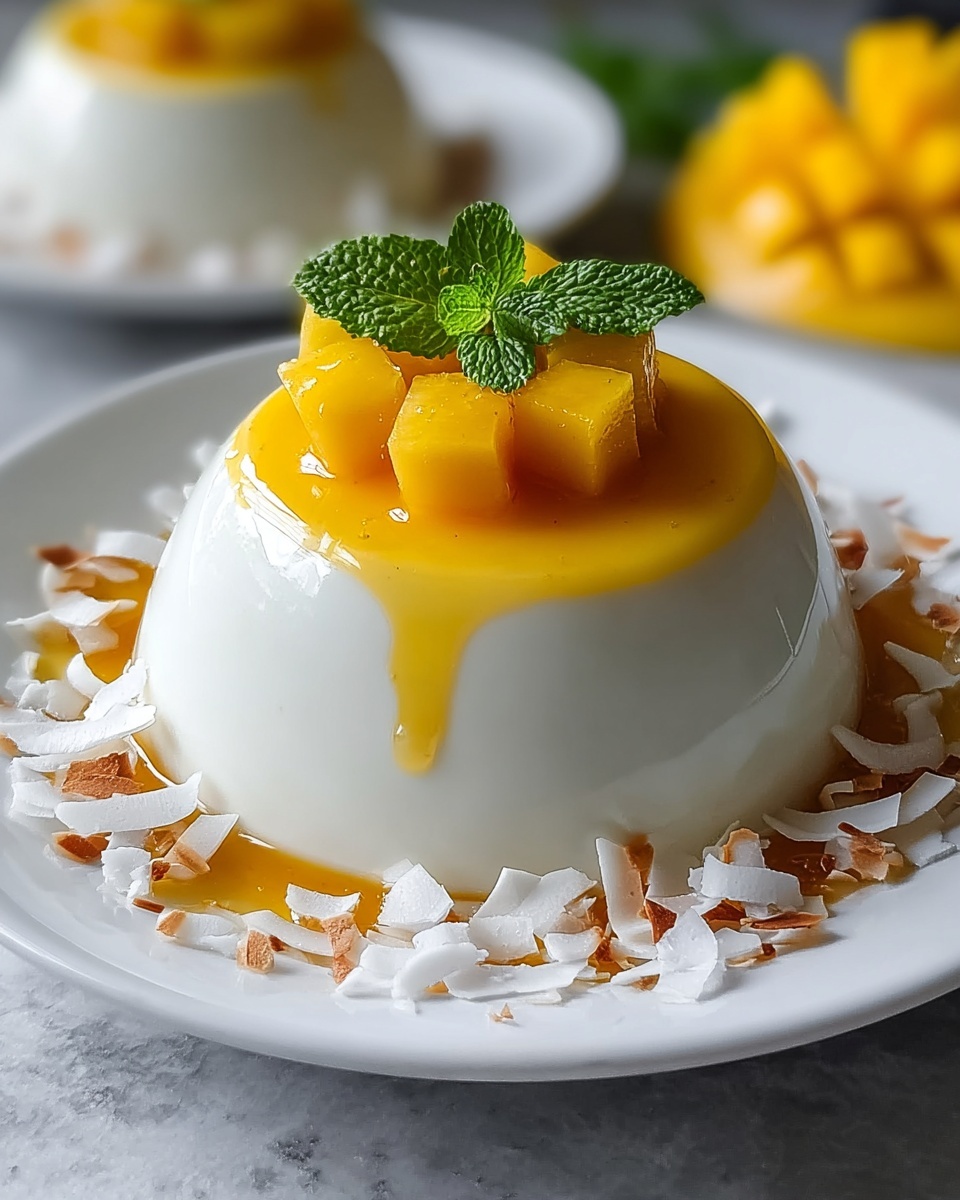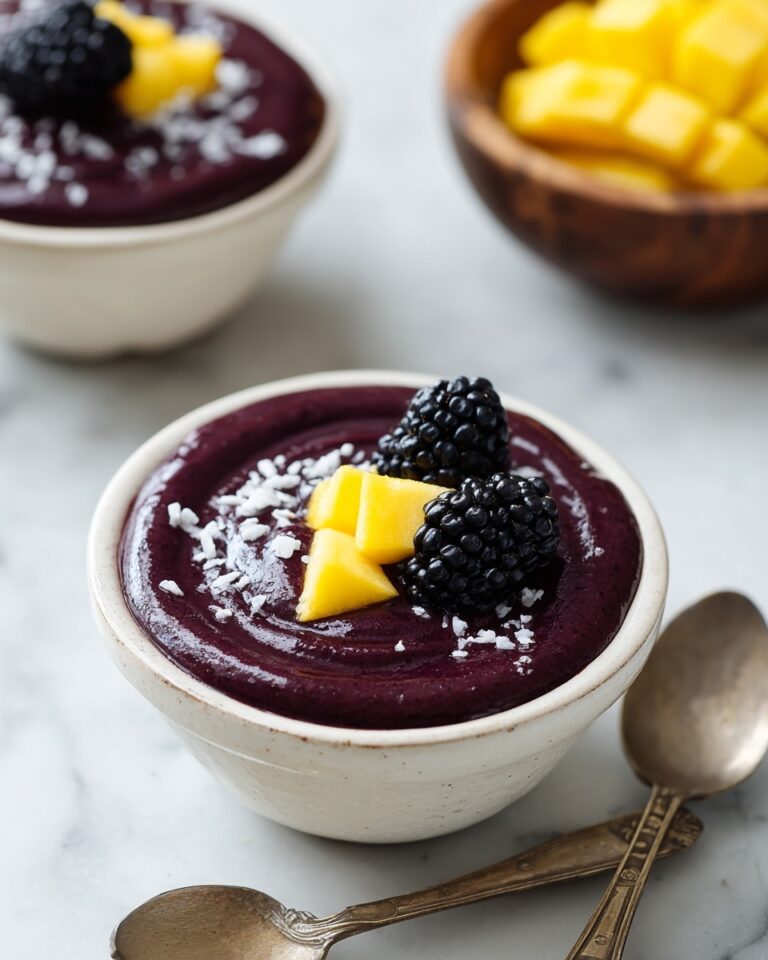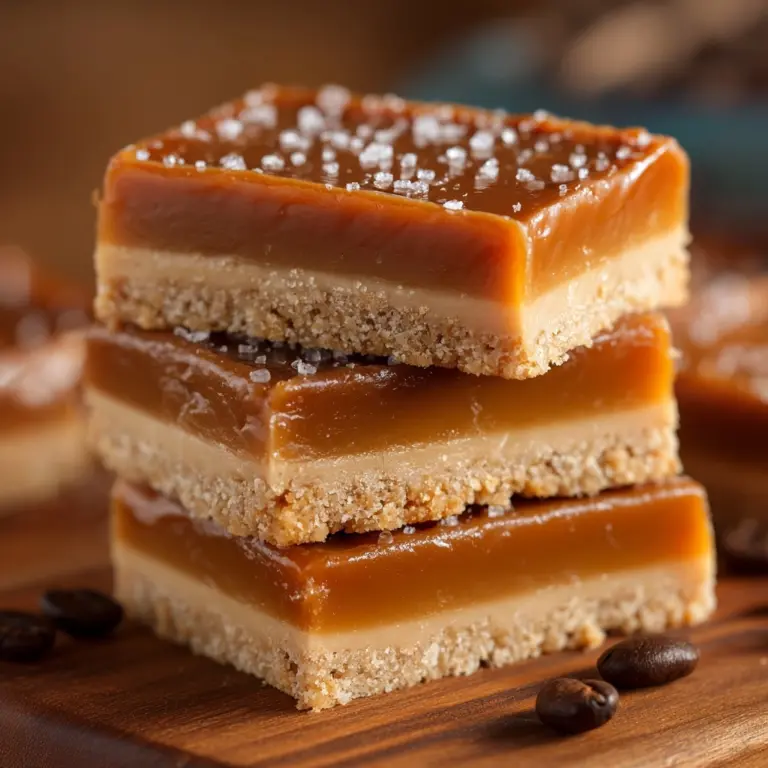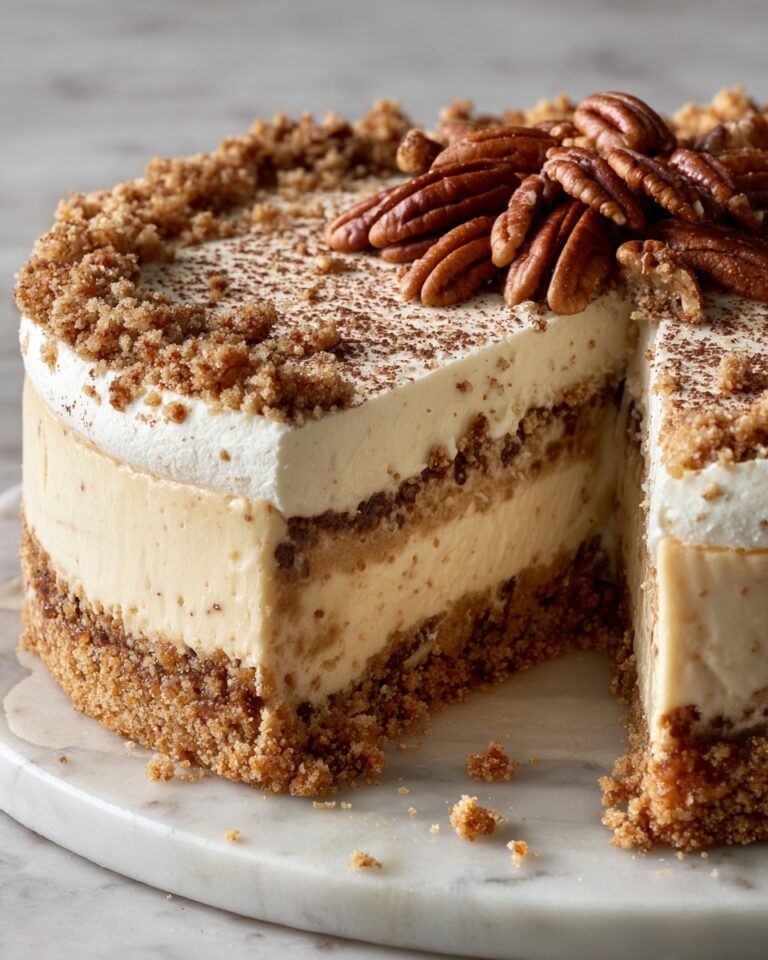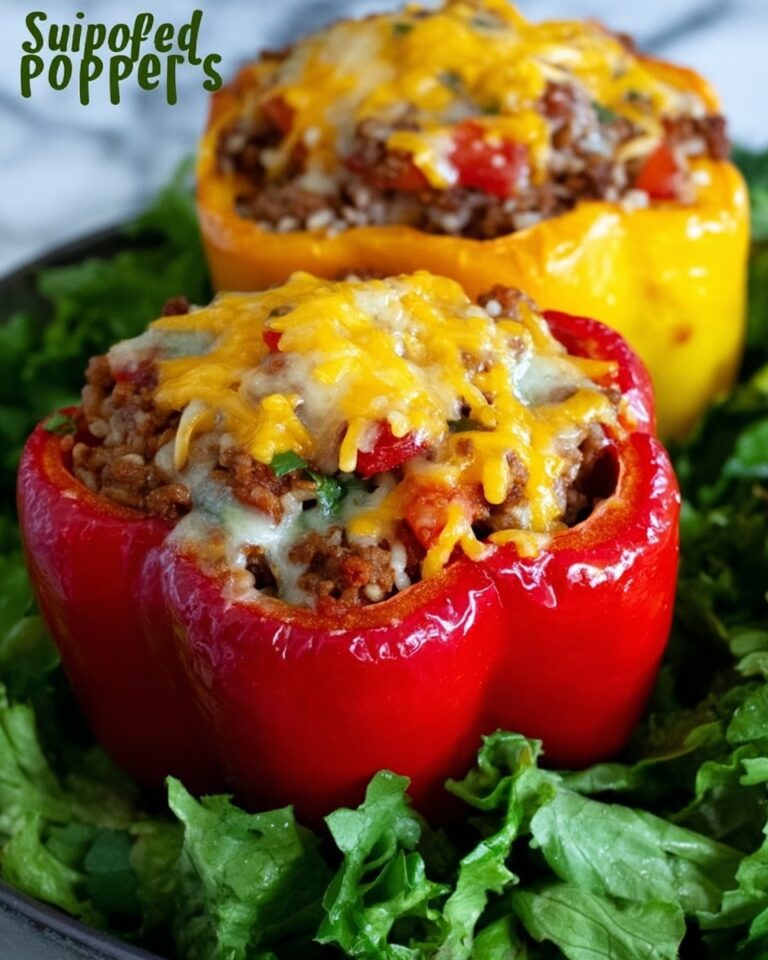If you are searching for a tropical dessert that feels like a mini vacation in every spoonful, this Mango Coconut Panna Cotta Recipe is an absolute must-try. Combining the velvety richness of coconut milk, the sweet and tangy freshness of ripe mangoes, and the smooth, creamy texture of panna cotta, this dessert is a celebration of flavor and simplicity. It’s perfect for impressing guests or simply indulging yourself with a luscious treat that’s both elegant and comforting. Once you try this Mango Coconut Panna Cotta Recipe, you’ll find it hard to resist making it again and again.

Ingredients You’ll Need
Gathering the right ingredients is the first step towards making this delightful dessert. Each element plays a crucial role, whether it’s contributing creaminess, sweetness, or that essential tropical flair. With these simple ingredients in your kitchen, you’re already halfway to a memorable treat.
- Unflavored gelatin (1 packet, 2 1/4 tsp): This is the magic that gives panna cotta its signature silky, set texture.
- Cold water (1/4 cup): Used to bloom the gelatin perfectly, ensuring a smooth finish.
- Full-fat coconut milk (1 can, 14 oz, divided): Provides the lush coconut flavor and creamy body that makes this panna cotta so inviting.
- Heavy cream (1/2 cup): Adds richness and balances the tropical coconut taste beautifully.
- Granulated sugar (1/3 cup plus 2 tablespoons): Sweetens both the coconut base and the mango layer to perfection.
- Vanilla extract (1 teaspoon): Enhances depth and rounds out the sweetness with its warm aroma.
- Pinch of salt: A tiny touch that elevates the overall flavor profile.
- Ripe mangoes (2 large, peeled and diced, about 2 cups): Fresh mangoes give this dessert its star tropical flavor and vibrant color.
- Fresh lime juice (2 tablespoons): Adds a lively citrus brightness that balances the sweetness.
- Lime zest (1 teaspoon): Intensifies the lime flavor with a fragrant boost.
- Fresh mango slices (for garnish): Adds visual appeal and extra fruity freshness to your presentation.
- Toasted coconut flakes (optional, for garnish): Offer a delightful crunch and reinforce the coconut theme.
- Fresh mint leaves (for garnish): Provide a pop of color and a refreshing scent to complement the dessert.
How to Make Mango Coconut Panna Cotta Recipe
Step 1: Bloom the Gelatin
Start by sprinkling the unflavored gelatin over cold water in a small bowl. Let it sit for five minutes until it becomes soft and spongy. This blooming process ensures the gelatin dissolves smoothly later on and results in that perfect panna cotta texture.
Step 2: Prepare the Coconut Gelatin Mixture
Warm half a cup of coconut milk over low heat until it’s hot but not boiling. Remove it from the heat, then whisk in the bloomed gelatin until it completely dissolves into the milk. This warm mixture will integrate harmoniously with the creamy base.
Step 3: Whisk the Coconut Layer
In a larger bowl, combine the remaining coconut milk, heavy cream, granulated sugar, vanilla extract, and a pinch of salt. Pour the warm gelatin-coconut milk mixture into the bowl, whisking constantly until the sugar has fully dissolved. This creates the luxurious coconut layer that forms the foundation of the dish.
Step 4: Blend the Mango Puree
Place the diced ripe mangoes into a blender along with the fresh lime juice, lime zest, and extra sugar. Blend until the mixture is perfectly smooth. Taste and adjust the sweetness if needed. This vibrant mango puree will be the bright, fruity layer on top.
Step 5: Assemble the First Layer
Divide the coconut mixture evenly among six serving glasses or ramekins, filling each about halfway. Pop them into the refrigerator for about two hours until this base layer is set but still slightly tacky to the touch. This step guarantees a clean separation between the coconut and mango layers.
Step 6: Add the Mango Layer
Once the coconut base is set, spoon the mango puree gently over each portion. For a fun touch, swirl the layers lightly with a toothpick to create eye-catching patterns. This not only makes it look stunning but melds the flavors beautifully.
Step 7: Final Chill
Refrigerate the assembled panna cottas for at least three hours, ideally overnight. This extended chill time allows the mango layer to set firmly, enhancing the texture and making sure every bite is perfect.
Step 8: Serve Like a Pro
Before serving, adorn your panna cotta with fresh mango slices, a sprinkle of toasted coconut flakes for crunch, and a few fresh mint leaves. These final touches bring freshness, texture, and an inviting aroma that will wow anyone lucky enough to taste it.
How to Serve Mango Coconut Panna Cotta Recipe
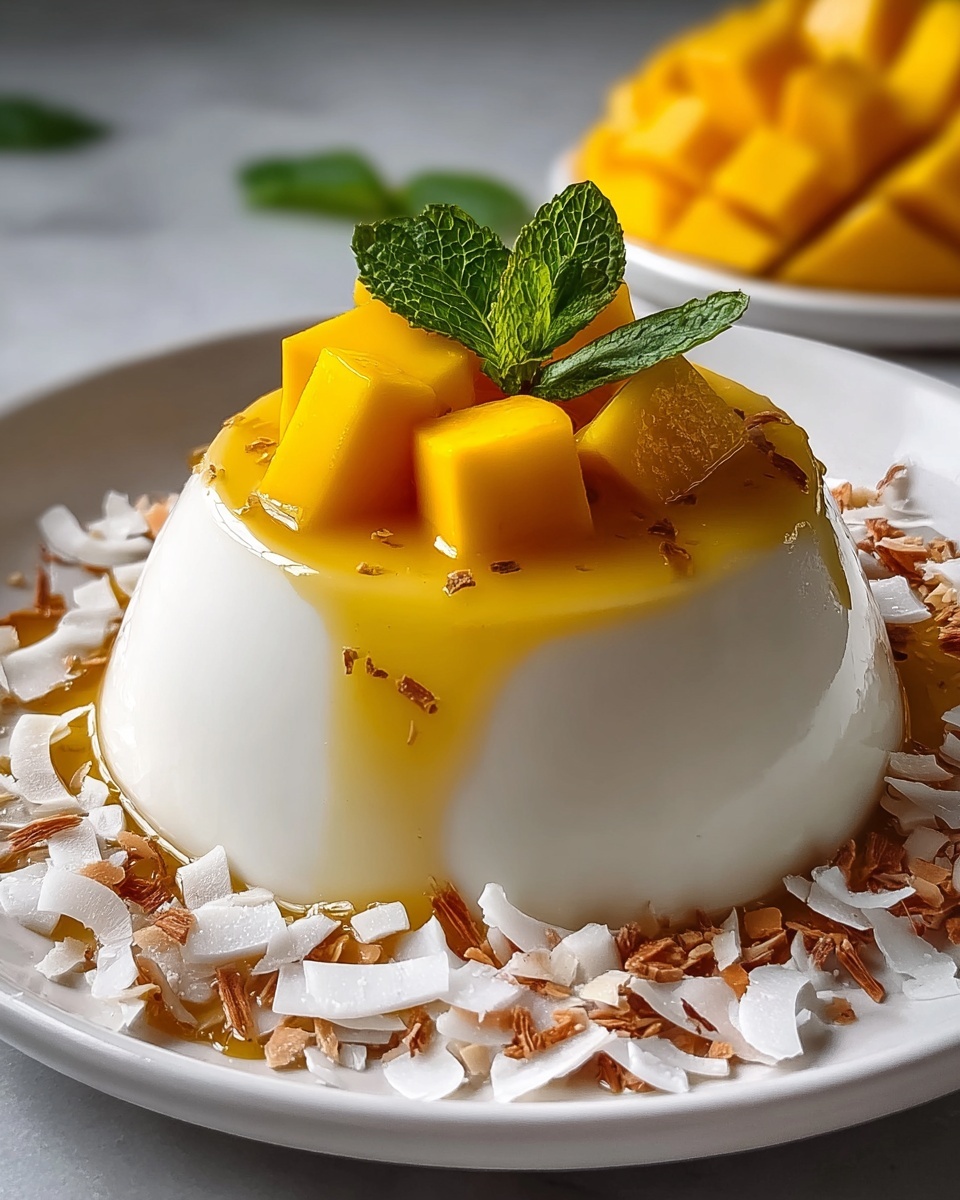
Garnishes
Garnishing this Mango Coconut Panna Cotta Recipe is where your creativity can shine. Fresh mango slices beckon with juicy sweetness, while toasted coconut flakes add a lovely contrast in texture. Mint leaves contribute a refreshing herbal note and a burst of green that breathes life into the presentation.
Side Dishes
This dessert pairs wonderfully with light, tropical side dishes. Think chilled pineapple or papaya salads, or even a scoop of coconut sorbet to complement the creamy panna cotta. A cup of fragrant jasmine or green tea also rounds out the meal beautifully without overpowering the delicate flavors.
Creative Ways to Present
Serve the panna cotta in small glass jars or clear ramekins to showcase the gorgeous layers of coconut cream and mango puree. For parties, consider using mini dessert cups or mason jars with tropical-themed straws and tiny edible flowers. You can also layer chunks of fresh mango inside the panna cotta itself before chilling for a delightful surprise.
Make Ahead and Storage
Storing Leftovers
If you have leftovers from your Mango Coconut Panna Cotta Recipe, keep them tightly covered in the refrigerator for up to three days. Make sure the lids or plastic wrap is secure to prevent the panna cotta from absorbing other fridge odors or drying out.
Freezing
Freezing panna cotta is generally not recommended because the creamy gelatin texture can become grainy or separate upon thawing. It’s best enjoyed fresh or within a few days stored cold.
Reheating
This panna cotta is best served chilled and does not require reheating. If it feels too firm from the fridge, let it sit at room temperature for five to ten minutes before serving to soften up slightly and reveal its delicate creaminess.
FAQs
Can I use agar-agar instead of gelatin?
Yes, agar-agar can be used as a vegetarian substitute for gelatin, but it sets more firmly and quickly, so you will need to adjust quantities and methods accordingly. It’s a good idea to follow specific agar-agar instructions to keep the silky texture of this panna cotta.
What if I can’t find fresh mangoes?
If fresh mangoes are unavailable, high-quality frozen mango chunks work well too. Make sure to thaw them completely and drain any excess juice before blending. This will help maintain the right consistency for the mango layer.
Can I make this recipe dairy-free?
Absolutely! You can substitute the heavy cream with full-fat coconut cream or a creamy plant-based alternative. This adjustment will keep the dessert creamy and coconut-forward while making it friendly for dairy-free diets.
How long does it take for the panna cotta to set?
Typically, the coconut panna cotta layer sets within two hours in the fridge, but for best results, it’s ideal to chill overnight after adding the mango layer. Setting times may vary based on refrigerator temperature and the type of gelatin used.
Can I prepare this recipe in advance for a party?
Definitely! This Mango Coconut Panna Cotta Recipe is perfect for preparing ahead of time. Make the coconut base and mango layer the day before your event and refrigerate overnight. Just add garnishes before serving to keep everything fresh and vibrant.
Final Thoughts
This Mango Coconut Panna Cotta Recipe is a joyful way to bring tropical sunshine to your kitchen and dinner table. Its creamy texture, bright mango flavor, and delicate balance of sweetness make it a dessert that’s both comforting and refreshing. I encourage you to give it a try—you might just find a new favorite to share with loved ones or savor as a special treat all to yourself!
Print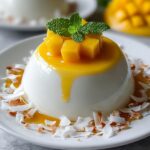
Mango Coconut Panna Cotta Recipe
- Prep Time: 15 minutes
- Cook Time: 10 minutes
- Total Time: 5 hours 25 minutes
- Yield: 6 servings
- Category: Dessert
- Method: No-Cook
- Cuisine: Tropical/International
- Diet: Gluten Free
Description
This Mango Coconut Panna Cotta is a luscious, tropical dessert featuring a creamy coconut milk base layered with vibrant mango puree. It’s a no-bake treat that combines the rich flavors of coconut and mango, complemented by fresh lime juice and garnished with toasted coconut flakes and mint for an elegant finish. Perfect for warm weather or any occasion that calls for a light, refreshing, yet indulgent sweet dish.
Ingredients
Coconut Panna Cotta Base
- 1 packet (2 1/4 tsp) unflavored gelatin
- 1/4 cup cold water
- 1 can (14 oz) full-fat coconut milk, divided
- 1/2 cup heavy cream
- 1/3 cup granulated sugar
- 1 teaspoon vanilla extract
- Pinch of salt
Mango Puree Layer
- 2 large ripe mangoes, peeled and diced (about 2 cups)
- 2 tablespoons fresh lime juice
- 2 tablespoons granulated sugar (adjust to taste)
- 1 teaspoon lime zest
Garnish
- Fresh mango slices
- Toasted coconut flakes (optional)
- Fresh mint leaves
Instructions
- Bloom the gelatin: Sprinkle the gelatin over the cold water in a small bowl and let it sit undisturbed for 5 minutes until it becomes spongy. This step ensures the gelatin dissolves smoothly later.
- Prepare the coconut base: Heat 1/2 cup of the coconut milk in a small saucepan over medium heat until it is hot but not boiling. Remove it from the heat and whisk in the bloomed gelatin until fully dissolved, ensuring a smooth mixture without lumps.
- Combine the panna cotta mixture: In a large mixing bowl, whisk together the remaining coconut milk, heavy cream, granulated sugar, vanilla extract, and a pinch of salt. Slowly add the warm coconut milk and gelatin mixture to the bowl, whisking continuously until all the sugar is fully dissolved and the mixture is uniform.
- Create the mango puree: Place the diced mangoes, fresh lime juice, sugar, and lime zest into a blender or food processor. Blend until completely smooth, tasting and adjusting the sweetness as needed to balance the tartness of the lime.
- Pour the first layer: Divide the coconut panna cotta mixture evenly among 6 serving glasses or ramekins, filling each about halfway. Place them in the refrigerator and chill for about 2 hours until the mixture is set but slightly tacky on top.
- Add the mango layer: Spoon the mango puree gently over the set coconut layer in each glass. Use a toothpick to swirl the layers together if you like a marbled effect or leave it smooth for a clean look.
- Final chilling: Return the glasses to the refrigerator and chill for at least 3 more hours, preferably overnight, to allow the mango layer to set and the flavors to meld beautifully.
- Serve and garnish: Just before serving, garnish each panna cotta with fresh mango slices, toasted coconut flakes for a crunchy contrast, and fresh mint leaves to add color and aroma for a professional presentation.
Notes
- To toast coconut flakes, heat a dry skillet over medium heat and stir the flakes frequently until golden brown and fragrant.
- For a vegan version, use agar-agar powder instead of gelatin and coconut cream in place of heavy cream.
- If mangoes are out of season, you can substitute with other tropical fruits like papaya or passion fruit, adjusting the sugar accordingly.
- Make sure not to boil the coconut milk when heating, as it can separate or curdle.
- For easier layering, cool the coconut base mixture to room temperature before pouring it into serving glasses.

